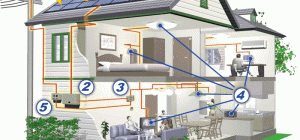 Solar power isn’t exactly a new concept in the world today. We’ve been exploring the potential of renewable energy solutions for several years, as our fossil fuel reliance becomes more significant, and we find ourselves running low on supplies. However, most people, both in the commercial and residential sectors, simply assumed that solar energy was too much of an expensive initial investment. There’s a lot of hardware and infrastructure to pay for, particularly if you want to adopt sustainable energy on a city-wide scale.
Solar power isn’t exactly a new concept in the world today. We’ve been exploring the potential of renewable energy solutions for several years, as our fossil fuel reliance becomes more significant, and we find ourselves running low on supplies. However, most people, both in the commercial and residential sectors, simply assumed that solar energy was too much of an expensive initial investment. There’s a lot of hardware and infrastructure to pay for, particularly if you want to adopt sustainable energy on a city-wide scale.
On top of that issue, there’s the concern that solar power and wind energy are both intermittent sources of power. In other words, you can’t rely on the sun to provide the same amount of energy at night, and turbines only generate electricity about 50% of the time that they’re in use. This means that we need a more strategic plan if we’re going to switch to sustainable energy.
The good news is that energy storage could be the answer. If energy storage can be accessed as a cost-effective way to fill the gaps when it comes to using sustainable power, then we could turn to renewable energy as a complete and comprehensive energy source. One study by Lazard, an investment bank, suggests that we might have already reached this point.
The Cost of Sustainable Energy and Storage
To help facilitate the drive towards sustainable energy solutions, Lazard performs an annual evaluation of the costs associated with renewable energy, in comparison to fossil fuels. This year, we’ve found that utility-scale solar power and wind-powered generators are both more cost-effective than natural gasses and coal. Of course, the conditions need to be right for this to remain true.
Where the facts become even more compelling, is when you add energy storage systems to the mix. The truth is that the cost of energy storage for solar power is more competitive than you might think. For instance, imagine that a 200 MW plant using solar power comes with a 400 MWH solution for energy storage. This will increase the cost of your solar projects to about 8.2 cents per KwH. However, this will mean that solar is still a competitive solution compared to natural gas turbines and coal.
In simple terms, if you’re thinking of using commercial solar panel systems to power your plant or company, then you can rest assured that you won’t be investing more than your budget can handle. After all, in comparison, it would cost you around 9.6 cents per KwH to create an integrated gasification combined cycle or clean plant for coal. Similarly, a nuclear plant would cost 11.2 cents per KwH, a gas peaking plant would cost 15.6 kWh, and a diesel reciprocating plant would cost 19.7 KwH.
Ultimately, you could save money on your energy without having to compromise on the amount of power you have access to throughout different parts of the day. This is particularly important as we go forward, and consider new economically viable solutions for a greener planet.

Solar Power Is Now Truly Sustainable
While there may be more research needed around the potential of solar power and storage costs, it’s worth noting that the evidence already exists to suggest that solar plus storage is more cost-effective than diesel and coal. With that in mind, it’s hard to imagine why utility companies would consider building those old-fashioned, and potentially damaging power plants in the future.
We know for a fact that there’s plenty of solar energy in the world to help keep our devices powered up, and now that solar is more economically viable, this could help to drive forward the adoption of lower-cost solutions for renewable energy. As the world searches for new ways to ensure the survival of our climate and our environment, this revolution in the costs around energy usage could be the way forward.
The delivery of energy storage devices not only makes solar energy more of a significant solution for commercial companies, it can also mean that expensive fossil fuel sources become practically irrelevant from a grid perspective. Operators today are already seeing the value of energy storage as part of their resource plans.







